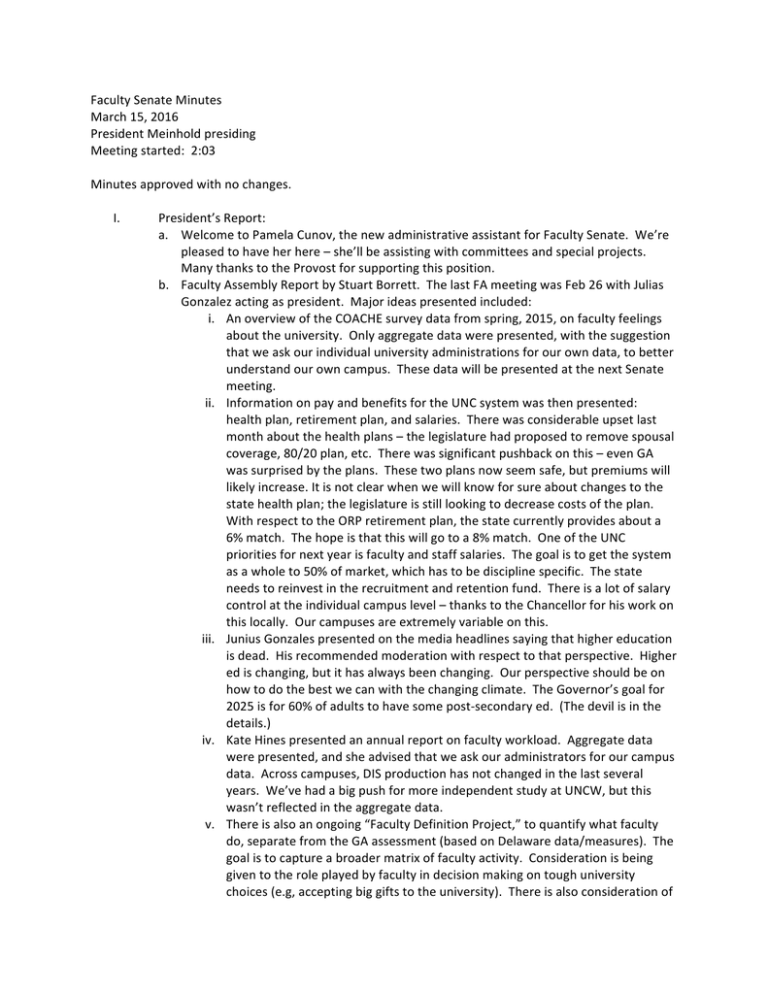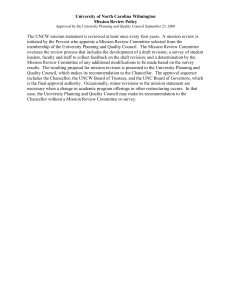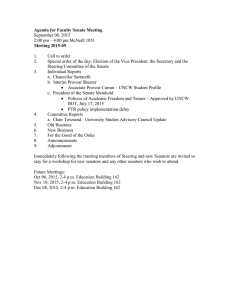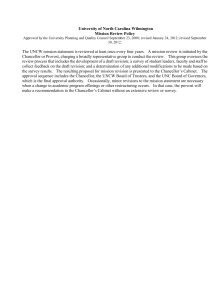Document 12007425
advertisement

Faculty Senate Minutes March 15, 2016 President Meinhold presiding Meeting started: 2:03 Minutes approved with no changes. I. President’s Report: a. Welcome to Pamela Cunov, the new administrative assistant for Faculty Senate. We’re pleased to have her here – she’ll be assisting with committees and special projects. Many thanks to the Provost for supporting this position. b. Faculty Assembly Report by Stuart Borrett. The last FA meeting was Feb 26 with Julias Gonzalez acting as president. Major ideas presented included: i. An overview of the COACHE survey data from spring, 2015, on faculty feelings about the university. Only aggregate data were presented, with the suggestion that we ask our individual university administrations for our own data, to better understand our own campus. These data will be presented at the next Senate meeting. ii. Information on pay and benefits for the UNC system was then presented: health plan, retirement plan, and salaries. There was considerable upset last month about the health plans – the legislature had proposed to remove spousal coverage, 80/20 plan, etc. There was significant pushback on this – even GA was surprised by the plans. These two plans now seem safe, but premiums will likely increase. It is not clear when we will know for sure about changes to the state health plan; the legislature is still looking to decrease costs of the plan. With respect to the ORP retirement plan, the state currently provides about a 6% match. The hope is that this will go to a 8% match. One of the UNC priorities for next year is faculty and staff salaries. The goal is to get the system as a whole to 50% of market, which has to be discipline specific. The state needs to reinvest in the recruitment and retention fund. There is a lot of salary control at the individual campus level – thanks to the Chancellor for his work on this locally. Our campuses are extremely variable on this. iii. Junius Gonzales presented on the media headlines saying that higher education is dead. His recommended moderation with respect to that perspective. Higher ed is changing, but it has always been changing. Our perspective should be on how to do the best we can with the changing climate. The Governor’s goal for 2025 is for 60% of adults to have some post-­‐secondary ed. (The devil is in the details.) iv. Kate Hines presented an annual report on faculty workload. Aggregate data were presented, and she advised that we ask our administrators for our campus data. Across campuses, DIS production has not changed in the last several years. We’ve had a big push for more independent study at UNCW, but this wasn’t reflected in the aggregate data. v. There is also an ongoing “Faculty Definition Project,” to quantify what faculty do, separate from the GA assessment (based on Delaware data/measures). The goal is to capture a broader matrix of faculty activity. Consideration is being given to the role played by faculty in decision making on tough university choices (e.g, accepting big gifts to the university). There is also consideration of II. faculty standing, including nontenure track positions, and the heterogeneity in treatment these positions receive across and even within campuses. A significant fraction of UNC faculty are nontenure track, and the work of lecturers is quite varied. vi. FA decided that its job is not to make recommendations on the bond issue. c. President Meinhold: i. The faculty rank issue at UNCW is a serious one that needs to be considered by the Senate, especially promotion policies to senior lecturer. Our previous senior lecturer policy was rejected by the prior provost. This generated a host of issues that we’ll need to address, including the nature of the responsibilities for lecturers – it’s often more than teaching classes (e.g., advising, sometimes scholarly contributions). Our policies really address lots of the issues that lecturers face. This conversation is started. ii. The Chancellors installation will take place on March 31 beginning at 10:30 on Hoggard Lawn, followed by a campus community lunch. Please make every effort to participate, and encourage your colleagues. Come in regalia – there will be a procession. Encourage students who are not in class to attend as well. Committee Reports: a. From the Academic Standards Committee: MO 2016-­‐03-­‐ M01. Revise declaration of major policy and catalogue language. i. Whereas, UNCW’s first-­‐year student body had changed tremendously over the last 15 years with more and more students bringing an increasing number of AP, IB, and early college credits with them; and Whereas, the current declaration of major policy is ambiguous in areas and does not specify a mechanism for enforcement in others; Resolved, that the University Regulations as outlined in the Undergraduate Catalogue be amended as follows (modifications in red/bold): Declaration of Major Undergraduate students admitted as freshmen may declare and be accepted into a major field of study after completing a minimum of 24 semester hours at the university. They must declare a major before or during the semester that they complete 45 semester hours of credit at UNCW. Students may be prevented from preregistering or registering for the following semester until a major or a pre-­‐major has been declared. Additional advising may be required prior to registration for continuing students who have completed 30 hours or more and have not declared a major or a pre-­‐major. ii. Nathan Grove, ASC Chair: The proposal is designed to maintain the status quo. The policy has been in place for 15 years, but has never actually been implemented until just recently, in preparation for an internal audit. The Registrar’s Office interpreted the policy as something they should be doing. It hasn’t been a big problem, and when it’s happened, there is usually a good reason. The Committee decided to strike the language at issue and continue doing what we’ve been doing up until recently. (Strike “Students may be prevented from preregistering or registering for the following semester until a major or a premajor has been declared”). The status quo would involve the III. advisor withholding the PIN if the situation warrants it. The paragraph at issue applies only to students accepted as freshmen. iii. There was no debate on the motion. The question was called, and the motion carried. Chancellor’s Report: a. Good afternoon. Congratulations to our basketball game, and don’t forget Thursday’s game against Duke. The team left today – this is very exciting and will put us on the map in a big way. Students have put forward a petition to cancel classes, and trustees got involved. The suggestion was to cancel the whole day! We said no – too much class time was involved, and this was the right decision for an academic institution. I hope have your support! b. The Provost is not here today, as her husband passed. Dr. Barlow is recovering from knee surgery. Our new Associate Vice Chancellor for distance learning, Dr. Ron Costello is visiting now. c. We had a robust BOG meeting, working to enhance Faculty Retention Fund and asking for 3 million. The Governor was in town to visit; I was urged by Spellings (who is working hard on salary issues) to speak with him about salary increases. He was noncommittal but sympathetic. We’ve put together a full analysis of NC Gap, which is a proposal to take the bottom rung of students and sent them back to community colleges. The idea is that this will allow the students to graduate faster and spend less; however, but these points are not true. It may cost less but students will graduate more quickly if they come here directly. NC Gap is not a good decision, and the Governor pretty much agreed, but it’s law now. It doesn’t help the students. Community colleges do have an important role to play and continued partnerships with them are important to us. UNCW, Charlotte and App St accept the highest number of CC students, and our graduation rates are the best. d. The remainder of the report was a review of the Strategic Plan, including the process and timeline. (Mark Lanier usually does this.) The full plan is 147 pages; the shortened version includes 50 pages of highlights. Both are posted on the web. Examples of some highlights from each of the five strategic priorities were presented, as was the case at the two forums held to present the plan. i. For Attract/Retain, there are specific enrollment targets for different categories of students. We will aim for up to 2,500 fall freshmen annually 5-­‐6 years from now, to increase transfers from 1,420 to 2,000 by 2021, to increase grad students from 1708 to 2500 total, to increase online enrollment from 1582 to 3000 total (mostly driven by new programs), and to increase international students from 350 to 1,000 total by 2020/21. We have specific goals for increasing retention and graduation rates, and for retaining faculty and staff. Estimates are that it will cost about 12 million to reach salaries for all at 100% of market, so this will take some time. This alone won’t eliminate the current compression, which is a major issue. We will continue to work with CITI funds to provide more for salary increases. There’s a chance that UNCW could change category due to our increasing number of doctoral programs, but this will mean a fight at the state level because of the increased salaries that would be required. We’re aiming for 80% of the median. ii. Plans for the “Advance University Academic Programming” priority include support for programs that the Deans are currently working on. We will have to iii. iv. v. vi. vii. viii. ix. x. work thoughtfully here to have programs that are of interest to our students and that meet market demands. A proposed PA program is of particular interest – there is huge demand locally. Many think it’s likely that we could get one here. We want future leaders for the NC community colleges, so there is the MS in Leadership in Community Colleges in Watson. We will support our new approved PhD programs, and there are lots of important metrics for successful programs. There are plans to enhance applied learning – in fact, there’s an entire section on this because we excel here. One goal is for 90% of our students to have at least 1 HIP by 20-­‐21. Faculty fellow and stipend programs are also planned. You may be wondering how we are going to do all of this. There are individuals designated as responsible for each of these goals, and there will be monthly meetings to review progress on each. The Chancellor is in favor of assigning a particular professional advisor for each student from the time they arrive until they graduate. We don’t want to lose the 10% we have been losing after freshman year. For “Advance Research and Scholarly Activities” – One goal is to reach $30 million in grants by 20-­‐21. (We had $12 million in 2013/14). How do we enable faculty to do more? How do we rethink the incentives for the extra work? For “Foster Global Learning and Research” – we already do a lot, but there are other possibilities. For “Enable/Place” – the emphasis will be on placing students after graduation. We want more companies coming here to recruit. We need to invite them, and help them appreciate our quality. For “Organize/Engage” – we do a lot already, but how can we do more at a higher quality. We’ve had good recommendations from a task force, and are still considering those and others. For “Fund/Build” – if I’m not thinking about a donor every day, I’m not doing my job. The same should be true for the Deans. Sometimes companies will give matching monies to put into a professorship, so you get two for one. We’re curerntly working on this. We need to figure out the specific interests of potential donors, which takes work. Donors will sometimes support a particular area. What are the areas of interest? That’s what we’re working on now, figuring out the priorities. We have to be able to match what our needs are with donor interests. There will also be emphasis on making sure that the state continues to fund and support us. The next steps include incorporating input from open forums, survey responses, etc.; preparing an abbreviated public version, incorporating plans into the installation address, implementing, monitoring, and revising (this will be “a living document”). There are a number of major metrics, and some soft ones too. The plan will be discussed at installation, but at a very high level. Questions from the floor: 1. How large a student body is anticipated in 5-­‐10 years? Response – We’re not completely sure. It’s important to maintain the quality, and retention, and we will probably be more successful in some areas than others. For example, there is lots of optimism for international increases – we have a good team there. On-­‐line enrollment will depend on particular programs – MSs in business are likely to attract students. 2. 3. 4. 5. Meeting adjourned – 3:27 The 12-­‐cell matrix is used by the state to accommodate growth. Without growth, we will not get more money. CHHS got increases due to enrollment increases in the Nursing program, but we’ll tap this out in a few years. We cannot increase the ratio of students to faculty. The 12-­‐cell matrix is the only solution. Next year, we will have a 2.1 million cut. How do we do that, without cutting faculty and staff, and grow at the same time? What are the plans for classroom space and renovations? Response – A team is working on a master plan, to deal with this, including dorm room needs. Assuming that the bond goes through, we’ll have a new building and lots of new funds. We will probably break ground in 12 months. A component of the master plan involves athletics, which is mostly supported by fees and donations. Baseball has been improved, and we’re working hard to fix track. The master plan will reflect the need for more classrooms, dorms, athletic facilities. $66 million would come from the bond, which includes repair and renovation. We’re also in line for additional R&R money from GA. This year we got only a small amount – about 2 million for next year for R&R. We’re hopeful, but the bond issue would be big. In the past, new buildings have been funded without a budget for maintenance and renovation. Normally about 10% is needed, but that hasn’t been in the scheme. There are questions about why we’d build a new building when old ones need fixing – that’s what the new monies are for. We need more classrooms. You’ve highlighted SAT numbers in other presentations. At many institutions, requirements for SAT are being removed, because those aren’t so indicative of performance. Why shoot for increasing those when the data say that will have little impact. Response – very few have actually given up on the SAT. Terry Curran– we take admissions from a wholistic perspective. SAT is one measure of academic rigor, but it’s only one piece. Testing against the clock is an issue. GPA is a much better index, especially in some areas. We don’t value SATs exclusively. Commendations to the Chancellor on the strategic planning process. It has been a collaborative process from the start, and has changed with our input. There may be things that some don’t like, but the whole will move us forward positively. We thank the Chancellor for that and for bringing the plan to the Senate. Applause. President Meinhold: I echo Aaron’s remarks. I asked the Chancellor to present to Senate today, and this will provide an opportunity for further input. We should also advocate to be involved in the implementation and monitoring phases of the plan. Thanks to all who have been involved and who may be asked to be involved in the future. Please make every effort to attend the installation.


